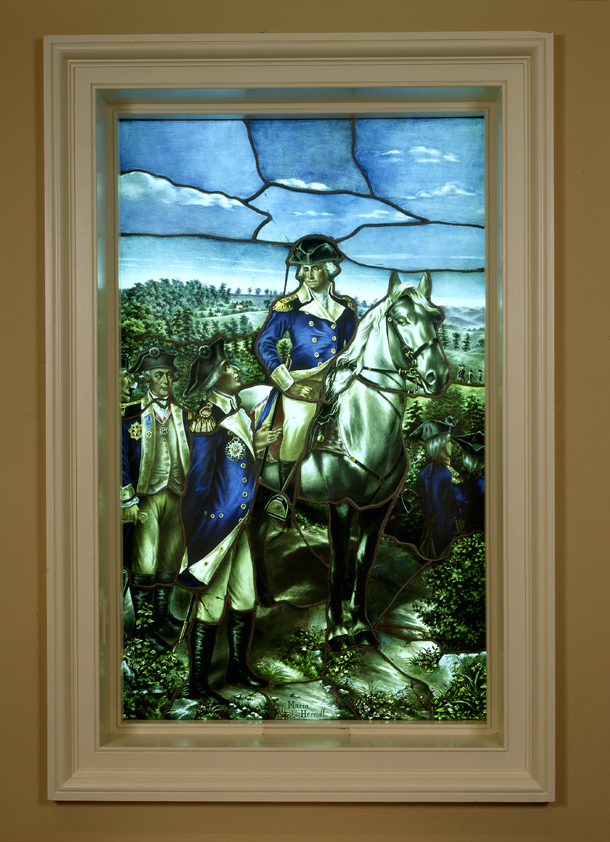
| Title | George Washington Memorial Window |
| Artist/Maker | Maria Herndl ( 1860 - 1912 ) |
| Date | 1904 ca. |
| Medium | Stained lead glass |
| Dimensions | h. 73.625 x w. 37.5 in. (h. 187.0075 x w. 95.25 cm) |
| Credit Line | U.S. Senate Collection |
| Accession Number | 42.00001.000 |
Artist Maria Herndl first contacted Architect of the Capitol Elliot Woods in December 1904 regarding the purchase of her stained glass window of George Washington. Woods was to receive numerous letters on the subject over the next six years from Herndl. The artist hoped to sell her window to the United States government for display in the U.S. Capitol or some other federal building in Washington, D.C. The piece had been exhibited at the St. Louis Exposition in 1904, where contemporary accounts praised the work and noted that it was awarded a medal.
Herndl’s passion for her project had already caused her some embarrassment–-as well as, perhaps, some welcome publicity. While President Theodore Roosevelt was in St. Louis, she was arrested by Secret Service agents for attempting to see him, with the intent of persuading him to purchase the window for the Capitol. A newspaper account recalled some years later, “Apologies were profuse when the mistake which they had made was discovered, and the plucky little woman was given a commission to paint President Roosevelt’s portrait.” [1]
In her frequent correspondence, Herndl fervently appealed for the purchase of her window. In November 21, 1906, she wrote to Woods, “I cannot express how anxious I am to have the matter of this Art-window come to the desired result; as it means all and everything to me my whole life.” Though Herndl was reassured that the delays were not any reflection on the work’s quality, but rather on the lack of space, she continued her efforts.
The government finally purchased the piece in 1910 for $1,800. Because there was still no suitable display area for the window, it was lent to the Smithsonian Institution. In 1962 the window was returned to the Capitol and placed on display in the Senators’ Dining Room (S-109).
Born in Munich, Bavaria, Maria Herndl studied in her homeland before moving to Milwaukee, Wisconsin, to create decorative windows for public and private buildings. She was the only woman of her time to achieve success as a stained glass artist. Herndl’s The Fairy Queen window received a medal at the World’s Columbian Exposition in Chicago in 1893, and her Hans Christian Andersen Window was completed in 1896 for the Milwaukee Public Library. The artist was working on a skylight for the Capitol when she died in 1912.
1. ”Miss Marie Herndl,” Milwaukee Journal, 16 May 1912.
This scene depicts General George Washington, Baron Friedrich von Steuben of Prussia, and the Marquis de Lafayette of France in a Revolutionary War setting at the time of the Battle of Yorktown. Lafayette and von Steuben served as division commanders during the engagement. General Washington sits astride a white horse in the center of the image, with Lafayette standing to his right and von Steuben pictured behind Lafayette. It was at Yorktown in 1781 where Washington and the Continental army defeated the British forces led by General Cornwallis.
Baron von Steuben, a former Prussian military officer, arrived in Portsmouth, New Hampshire, in 1777 to aid the war effort, without pay or rank. Through strict training, von Steuben transformed a tired, ragged army into one that would triumph at Yorktown.
Lafayette, hearing of the plight of the colonies, purchased a ship with money inherited from his grandfather and sailed to America. At the age of 19, he was appointed major general in the Continental army. Like von Steuben, Lafayette also refused payment for his services. He became both a close friend and trusted advisor to Washington. In 1779 Lafayette traveled to his homeland to solicit French support for the colonies. He returned to America to aid Washington in his defeat of Cornwallis and the British at Yorktown, the last major battle of the American Revolution.